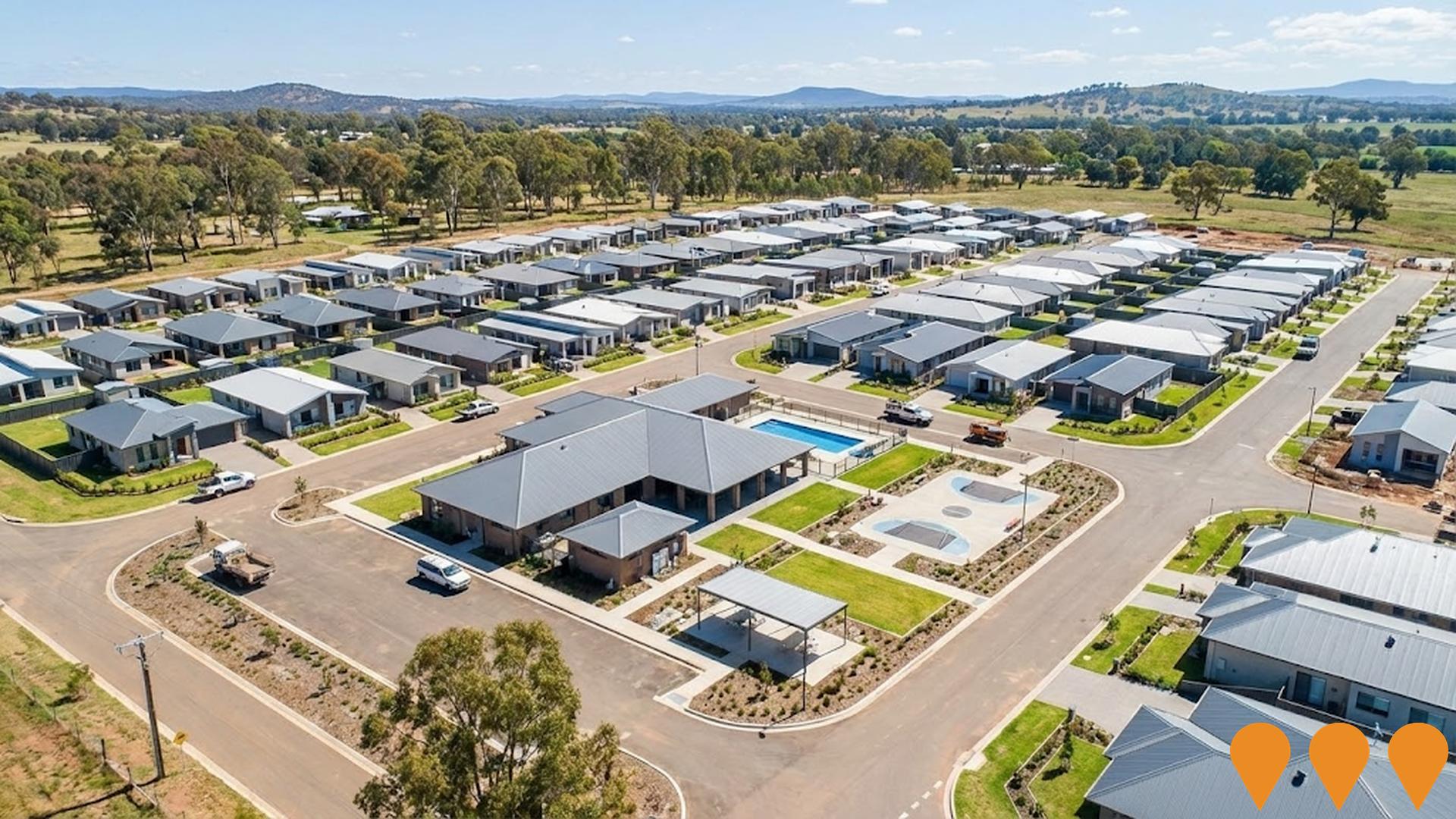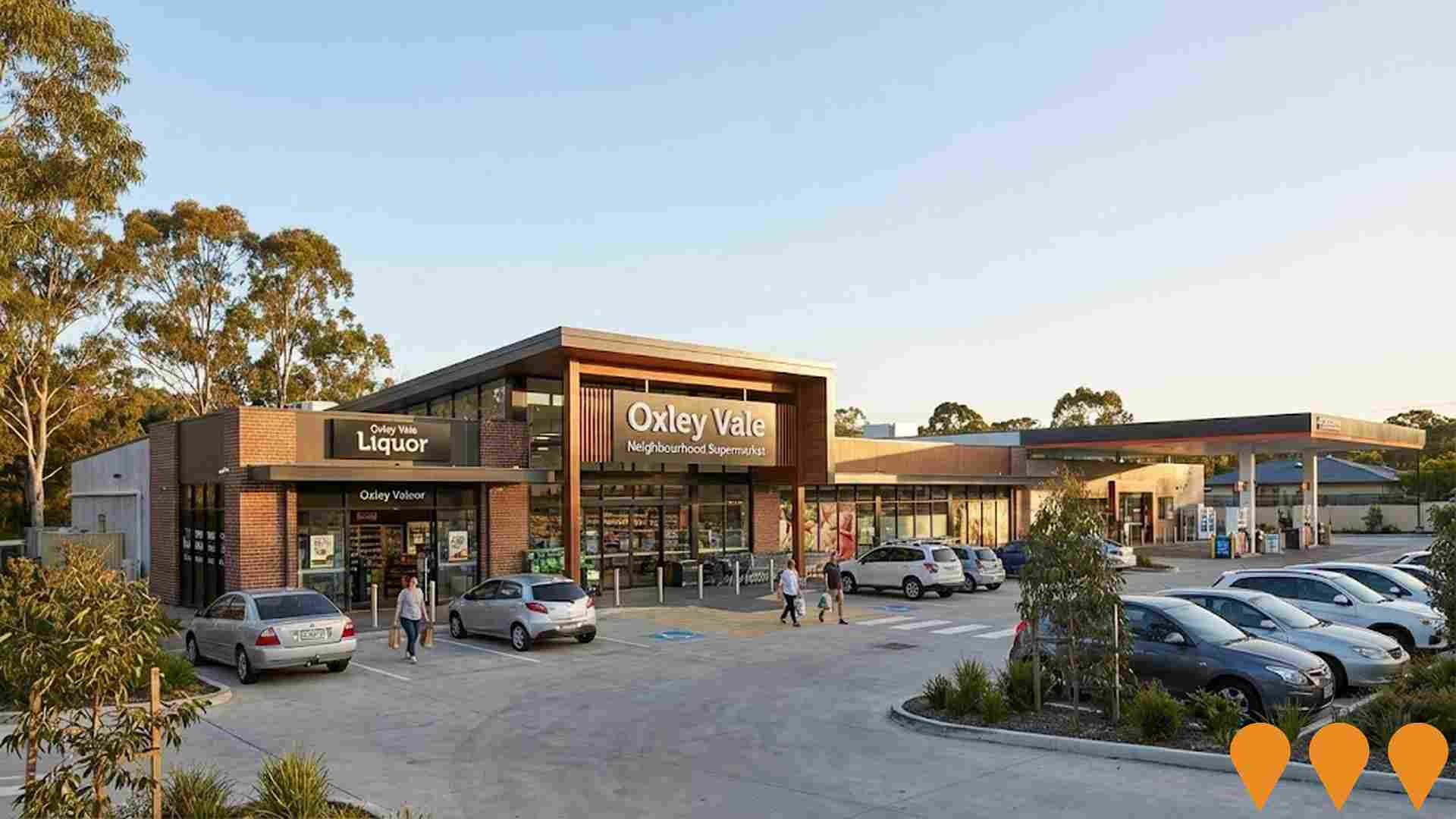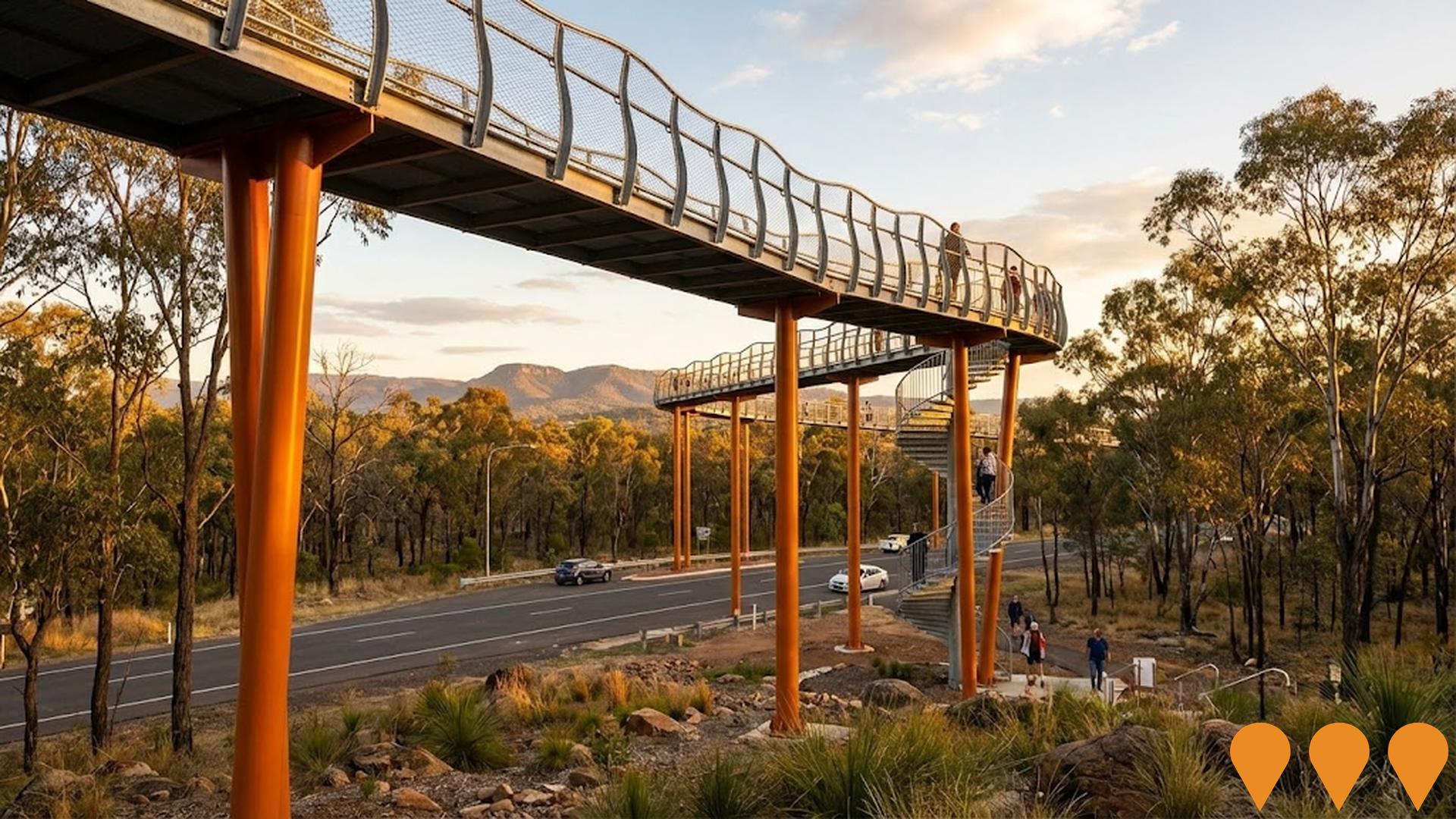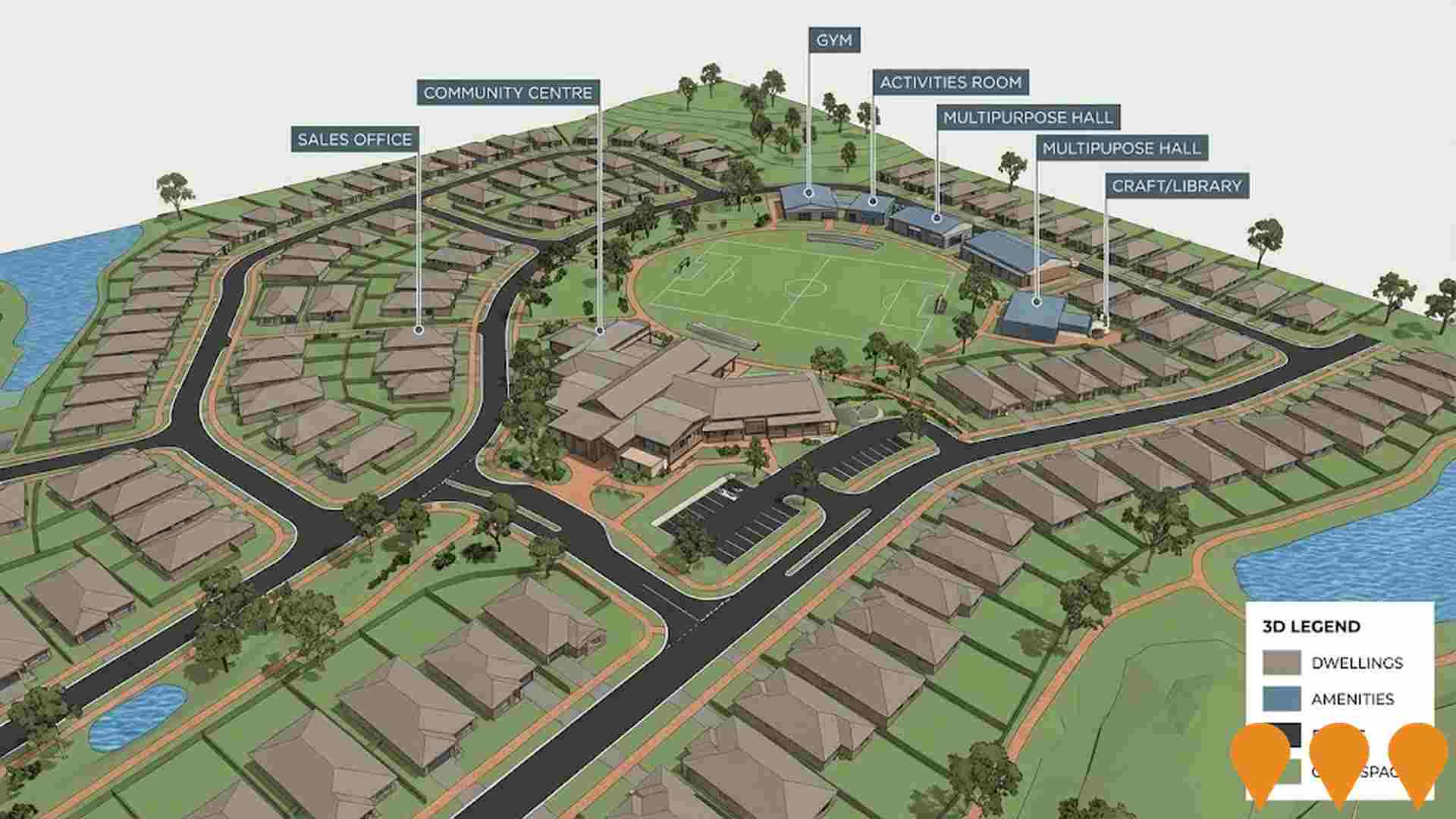Chart Color Schemes
est. as @ -- *
ABS ERP | -- people | --
2021 Census | -- people
Sales Activity
Curious about local property values? Filter the chart to assess the volume and appreciation (including resales) trends and regional comparisons, or scroll to the map below view this information at an individual property level.
Find a Recent Sale
Sales Detail
Population
Population growth drivers in Tamworth - West are strong compared to national averages based on AreaSearch's ranking of recent, and medium to long-term trends
Tamworth - West's population was around 7,246 as of November 2025, according to AreaSearch's analysis. This figure represents a growth of 1,248 people (20.8%) since the 2021 Census, which reported a population of 5,998 people. The increase is inferred from the estimated resident population of 6,531 in June 2024 and an additional 346 validated new addresses since the Census date. This results in a population density ratio of 115 persons per square kilometer, indicating significant space per person and potential for further development. Tamworth - West's growth rate of 20.8% since the 2021 census exceeded the SA4 region (4.4%) and the non-metro area, positioning it as a growth leader in the region. Natural growth contributed approximately 63.2% of overall population gains during recent periods.
AreaSearch adopted ABS/Geoscience Australia projections for each SA2 area, released in 2024 with 2022 as the base year. For areas not covered by this data, AreaSearch utilized NSW State Government's SA2 level projections released in 2022 with 2021 as the base year. Growth rates by age group from these aggregations were applied to all areas for years 2032 to 2041. Based on projected demographic shifts, a significant population increase is forecasted in the top quartile of Australia's non-metropolitan areas. The area is expected to expand by 1,540 persons to 2041, with an overall increase of 10.2% over the 17-year period.
Frequently Asked Questions - Population
Development
Recent residential development output has been above average within Tamworth - West when compared nationally
Tamworth - West has received approximately 38 dwelling approvals annually over the past five financial years, totalling 193 homes. Up to May 2026, 28 approvals have been recorded. On average, each dwelling accommodates around two new residents per year, indicating a healthy demand that supports property values. The average construction cost of new homes is approximately $230,000, which is below regional levels, offering more affordable housing options for buyers.
This financial year has seen $23.9 million in commercial development approvals, indicating moderate commercial growth. Compared to the rest of NSW, Tamworth - West has slightly higher development activity, with 33.0% more approvals per person over the past five years, balancing buyer choice while supporting current property values. Recent construction comprises 47.0% standalone homes and 53.0% medium and high-density housing, shifting from the area's existing housing composition of 95.0% houses. This change reflects decreasing availability of developable sites and evolving lifestyles requiring more diverse and affordable housing options. The current population density is approximately 231 people per dwelling approval, suggesting room for growth.
By 2041, Tamworth - West is projected to grow by 736 residents. At the current development rates, new housing supply should comfortably meet demand, providing favourable conditions for buyers and potentially supporting growth beyond current population projections.
Frequently Asked Questions - Development
Infrastructure
Tamworth - West has limited levels of nearby infrastructure activity, ranking in the 18thth percentile nationally
Changes to local infrastructure significantly influence an area's performance. AreaSearch has identified 18 projects likely to impact the area. Notable projects include Tamworth Global Gateway Park, Rosary College Lifestyle Community, Maintenance and Workshop Buildings, and Majestic Tamworth. The following list details those most relevant.
Professional plan users can use the search below to filter and access additional projects.
INFRASTRUCTURE SEARCH
 Denotes AI-based impression for illustrative purposes only, not to be taken as definitive under any circumstances. Please follow links and conduct other investigations from the project's source for actual imagery. Developers and project owners wishing us to use original imagery please Contact Us and we will do so.
Denotes AI-based impression for illustrative purposes only, not to be taken as definitive under any circumstances. Please follow links and conduct other investigations from the project's source for actual imagery. Developers and project owners wishing us to use original imagery please Contact Us and we will do so.
Frequently Asked Questions - Infrastructure
Oxley Vale Lifestyle Estate
A staged 218-dwelling manufactured housing estate designed as a land lease community for the aging population, including communal facilities such as a clubhouse, pool, and recreational areas. The project aims to address regional housing shortages in Tamworth, NSW.

Tamworth Sports and Entertainment Precinct
A comprehensive structure plan to transform the sports and entertainment area into a premier regional destination. The precinct encompasses AELEC (Australian Equine and Livestock Events Centre), TRECC (Tamworth Regional Entertainment and Conference Centre), Northern Inland Centre of Sporting Excellence (NICSE), former athletics track, and Longyard Golf Course. Key developments include a $48.6 million AELEC expansion with Western and Eastern wings, a $45 million aquatic centre and health facility, establishment of Special Entertainment Precincts to support live music and events, improved road connections, tourist accommodation, and enhanced sporting facilities. The precinct aims to generate greater economic benefits from events and tourism while providing world-class recreational facilities for the community.

Goonoo Goonoo Commercial Precinct
A 52-hectare (130-acre) large-format retail and commercial precinct, the last E3-zoned land in Tamworth's Longyard bulky goods area. Anchored by a full-line Woolworths supermarket with neighbourhood retail including chemist, GP, childcare and ancillary tenancies. Offers flexibility for large-format retailers and business uses across multiple stages and 41+ lots. Bulk earthworks completed and progressing well; civil construction underway and due for completion end-2025, with lot registration early 2026. Provides direct access to New England Highway and acts as a major economic catalyst for South Tamworth.

Oxley Vale Neighbourhood Supermarket
Redevelopment of the existing site, known as Lots A and B DP 161758, which currently contains the 'Oxleyvale Superette', into a neighbourhood supermarket, liquor retail outlet, and service station with associated parking and loading facilities to support local community growth. The project required an amendment to the Tamworth Regional Local Environmental Plan 2010 (TRLEP 2010) via a Planning Proposal (Phase 1 Review) to re-zone the land to E1 - Local Centre, which has been approved by the NSW Government and adopted by Council. The Planning Proposal aimed to enable the neighbourhood supermarket development which was previously prohibited in the R1 - General Residential zone.

Tamworth Regional Skywalk
A 1.5km elevated walking platform rising through the tree canopy from Endeavour Drive to Oxley Scenic Lookout in Victoria Park, featuring three viewing platforms and two rest areas. Designed as a premier regional tourist attraction providing safe pedestrian access with commanding views toward the Liverpool Ranges. Construction commenced in late 2024 with footing installation underway and main structure assembly beginning mid-2025. The project prioritizes accessibility with 85% of the structure providing ramped access compliant with Australian Standards.

Tamworth Global Gateway Park
Tamworth Global Gateway Park is a 246-hectare, council-owned, master-planned enterprise and logistics park at Westdale, adjacent to Tamworth Regional Airport. The multi-stage project includes serviced industrial and commercial lots, internal access roads, trunk stormwater infrastructure, upgraded heavy vehicle access (including the Country Road and Oxley Highway roundabout), and a Qube-operated intermodal rail freight terminal. Early infrastructure works and stages 1-2 are substantially complete, most initial lots are sold or under contract, and further stages continue through the 2020s-2030s, driving regional economic growth and employment.

Rosary College Lifestyle Community
Transformation of the derelict Rosary College site into an over-50s lifestyle community featuring 158 dwellings with modern homes and comprehensive amenities. The land lease community will include a gym, sales office, sports lounge, activities room, multipurpose hall, and craft/library room. The development aims to provide low-maintenance living with modern homes for residents looking to downsize or join a vibrant new community at an affordable price. The site has been vacant since 2003 and has been an eyesore for the local community.

Goonoo Goonoo Road Upgrade
A $58.4 million upgrade of Goonoo Goonoo Road on the New England Highway to improve safety, traffic flow, and support regional growth. The priority northern section between Craigends Lane and Calala Lane will be upgraded first, including duplication to two lanes each direction, replacing the Calala Lane roundabout with traffic signals, adding turning lanes, and building new pedestrian infrastructure. The road serves over 20,000 motorists daily and is a critical freight link for the Tamworth region.

Employment
AreaSearch analysis reveals Tamworth - West recording weaker employment conditions than most comparable areas nationwide
Tamworth - West has a balanced workforce with both white and blue collar jobs. Manufacturing and industrial sectors are prominent, with an unemployment rate of 5.4% as of June 2025.
Employment growth over the past year was estimated at 5.0%. There are 3,039 residents in work, with an unemployment rate of 1.7% above Rest of NSW's rate of 3.7%. Workforce participation is lower than standard, at 53.5% compared to Rest of NSW's 56.4%. Manufacturing, health care & social assistance, and retail trade are the dominant employment sectors among residents.
Manufacturing has a particularly high representation, with an employment share 3.0 times the regional level. Conversely, education & training is under-represented, with only 4.8% of Tamworth - West's workforce compared to 9.6% in Rest of NSW. The resident-to-worker ratio indicates substantial local employment opportunities, at 1:1 as per the Census. Over the 12 months to June 2025, employment increased by 5.0%, while labour force grew by 3.5%, reducing the unemployment rate by 1.4 percentage points. In contrast, Rest of NSW saw employment decline by 0.1% and labour force growth of 0.3%, with a rise in unemployment of 0.4 percentage points. National employment forecasts from Jobs and Skills Australia (May 2025) project national employment expansion of 6.6% over five years and 13.7% over ten years. Applying these projections to Tamworth - West's employment mix suggests local growth of approximately 5.3% over five years and 12.0% over ten years, though this is a simple weighting extrapolation for illustrative purposes only.
Frequently Asked Questions - Employment
Income
The area's income levels rank in the lower 15% nationally based on AreaSearch comparative data
AreaSearch's latest postcode level ATO data for financial year 2022 shows that Tamworth - West has an income below the national average. The median income is $43,604 while the average income stands at $52,531. This contrasts with Rest of NSW's figures where the median income is $49,459 and the average income is $62,998. Based on Wage Price Index growth of 12.61% since financial year 2022, current estimates for Tamworth - West would be approximately $49,102 (median) and $59,155 (average) as of September 2025. Census data reveals that household, family and personal incomes in Tamworth - West all fall between the 16th and 21st percentiles nationally. Income brackets indicate that the predominant cohort spans 30.3% of locals (2,195 people) in the $1,500 - $2,999 category, which aligns with the metropolitan region where this cohort likewise represents 29.9%. Housing affordability pressures are severe in Tamworth - West, with only 81.2% of income remaining, ranking at the 14th percentile.
Frequently Asked Questions - Income
Housing
Tamworth - West is characterized by a predominantly suburban housing profile, with a higher proportion of rental properties than the broader region
Tamworth - West's dwelling structure, as per the latest Census, comprised 95.1% houses and 4.9% other dwellings. In comparison, Non-Metro NSW had 89.5% houses and 10.4% other dwellings. Home ownership in Tamworth - West was at 23.0%, with mortgaged dwellings at 28.3% and rented ones at 48.7%. The median monthly mortgage repayment was $1,387, lower than Non-Metro NSW's $1,500. Median weekly rent in Tamworth - West was $290, compared to Non-Metro NSW's $300. Nationally, Tamworth - West's mortgage repayments were significantly lower at $1,387 versus Australia's average of $1,863, and rents were substantially below the national figure of $375.
Frequently Asked Questions - Housing
Household Composition
Tamworth - West features high concentrations of group households, with a higher-than-average median household size
Family households comprise 72.9% of all households, including 26.2% couples with children, 21.9% couples without children, and 23.2% single parent families. Non-family households account for the remaining 27.1%, with lone person households at 23.2% and group households comprising 3.8%. The median household size is 2.7 people, higher than the Rest of NSW average of 2.4 people.
Frequently Asked Questions - Households
Local Schools & Education
Tamworth - West faces educational challenges, with performance metrics placing it in the bottom quartile of areas assessed nationally
The area's university qualification rate is 9.0%, significantly lower than the NSW average of 32.2%. This disparity presents both a challenge and an opportunity for targeted educational initiatives. Bachelor degrees are most common at 6.6%, followed by postgraduate qualifications (1.3%) and graduate diplomas (1.1%). Vocational credentials are prominent, with 40.3% of residents aged 15+ holding such qualifications - advanced diplomas at 7.1% and certificates at 33.2%.
Educational participation is high, with 36.5% of residents currently enrolled in formal education. This includes 16.4% in primary education, 10.8% in secondary education, and 1.5% pursuing tertiary education. The area has two schools serving a total of 1,040 students: Peel High School and Westdale Public School. Educational provision follows conventional lines, with one primary and one secondary institution.
Frequently Asked Questions - Education
Schools Detail
Nearby Services & Amenities
Transport
Transport servicing is moderate compared to other areas nationally based on assessment of service frequency, route connectivity and accessibility
Transport analysis shows 159 active transport stops in Tamworth - West, all of which are bus stops. These stops are served by 57 individual routes that together offer 508 weekly passenger trips. The accessibility of public transport is rated as excellent, with residents typically located 107 meters from the nearest stop.
On average, there are 72 trips per day across all routes, which equates to approximately 3 weekly trips per individual stop.
Frequently Asked Questions - Transport
Transport Stops Detail
Health
Health performance in Tamworth - West is well below average with prevalence of common health conditions notable across both younger and older age cohorts
Tamworth - West faces significant health challenges, as indicated by health data. Both younger and older age groups have notable prevalence of common health conditions. Private health cover is low, at approximately 47% (around 3,383 people), compared to Rest of NSW's 50.0%, and the national average of 55.3%.
The most prevalent medical conditions are asthma and mental health issues, affecting 11.3% and 11.2% of residents respectively. About 64.3% of residents report no medical ailments, compared to Rest of NSW's 63.4%. The area has 12.1% (879 people) aged 65 and over, lower than Rest of NSW's 19.9%. Health outcomes among seniors present some challenges, generally mirroring the overall population's health profile.
Frequently Asked Questions - Health
Cultural Diversity
Tamworth - West is considerably less culturally diverse than average when assessed alongside AreaSearch's national rankings for language and cultural background related metrics
Tamworth-West showed lower cultural diversity, with 82.8% citizens, 89.8% born in Australia, and 91.6% speaking English only at home. Christianity was the dominant religion at 54.1%, compared to 63.6% across Rest of NSW. The top three ancestry groups were Australian (32.6%), English (25.8%), and Australian Aboriginal (19.5%), which is substantially higher than the regional average of 9.4%.
Notably, Filipino representation was overrepresented at 2.7%, compared to 0.7% regionally, and Maori at 0.6%, compared to 0.2%.
Frequently Asked Questions - Diversity
Age
Tamworth - West hosts a very young demographic, ranking in the bottom 10% of areas nationwide
Tamworth-West has a median age of 30 years, which is significantly lower than the Rest of NSW average of 43 years and the Australian median of 38 years. Compared to the Rest of NSW, Tamworth-West has a higher proportion of residents aged 25-34 (16.9%) but fewer residents aged 65-74 (6.6%). Between the 2021 Census and the present day, the population aged 25-34 has increased from 15.0% to 16.9%, while the proportion of those aged 5-14 has decreased from 18.1% to 16.5%. The percentage of residents aged 55-64 has also dropped, from 9.1% to 8.0%. By 2041, demographic modeling indicates that Tamworth-West's age profile will change significantly. The number of residents aged 25-34 is projected to grow by 29%, adding 354 people to reach a total of 1,575 in this age group. Conversely, both the 5-14 and 75-84 age groups are expected to see a decrease in numbers.





